Mercedes surprised the paddock when it revealed a dramatic new sidepod design for the second pre-season test one week ago today.

During the test Formula 1’s chief technology officer Pat Symonds referred to a company he believes Mercedes have worked with on the development of their intercooler.
“The intercooler I think comes from Reaction Engines in Oxfordshire, people who are doing this sort of air-breathing rocket motor. The spin-off from that has been this really, extremely efficient heat exchanger technology and I think that’s part of the reason why they’ve been able to produce the car the way they have.”
Mercedes encountered problems with cooling in the past, notably at the Austrian Grand Prix in 2019. Their subsequent development path appears to have led them to some cutting-edge solutions.
How to keep a Formula 1 car cool
The ultimate goal in Formula 1 is to be the fastest car and finish the race first. In order to have the quickest time on the board, the teams have to balance four key factors: power, grip, drag, and weight.Cooling plays a key role in three of these. Better cooling can lead to more power, either at peak or over the race; more efficient cooling can lead to less drag; and an innovative cooling design can lead to a lighter package overall.
There are several key components that must be cooled in an F1 car. These include the inlet air after being compressed by the turbocharger (also known as ‘charge air’), the hybrid system, V6 engine and various low voltage electronics (such as the ECU).
The majority of the powertrain systems such as the electric motors (MGU-K and MGU-H), inverters, ERS high-voltage battery pack, and the internal combustion engine use liquid cooling. The coolant moves the heat away from the hot powertrain components and flows through the channels of a radiator, gets cooled by the air passing through, and is returned to the components.
The cooler the powertrain components can be kept, the hotter they can run and for longer, improving performance and reliability. This cooling system is conceptually the same as what you would find in a standard road car.
Advert | Become a RaceFans supporter and
The intercooler
The only medium that is cooled to gain direct performance is the charge air being fed to the engine. While compressing the air using the turbocharger makes it denser for combustion, it also raises its temperature. As inlet temperature is critical to performance in an engine, the charge air is passed through a heat exchanger called an intercooler.
The basic idea is that as the hot charge air runs through channels of the intercooler, a cooler fluid, usually ambient air, is passed over the intercooler and the heat from the charge air is transferred to the ambient air. This is called an ‘air to air’ intercooler and is common in everyday cars.
Another type of intercooler is an ‘air to water’ intercooler. In this case, the same hot compressed intake goes into the intercooler but is cooled by water. The water is then cooled by a secondary radiator by ambient air.
This design has trade-offs. On one hand, the intercooler is less affected by vehicle speed as the water can retain heat and act as a ‘capacitor’ of heat for a short period of time. This is especially helpful at race starts where you have a relatively slow formation lap and sit on the grid for a few minutes.
A normal ‘air to air’ intercooler would get very little cooling as the car is not moving on the grid and F1 cars do not have fans on intercoolers or radiators. But on the other hand, this ‘air to water’ system requires a secondary cooling loop to cool the water resulting in a more complex design and additional weight.
Optimising cooling
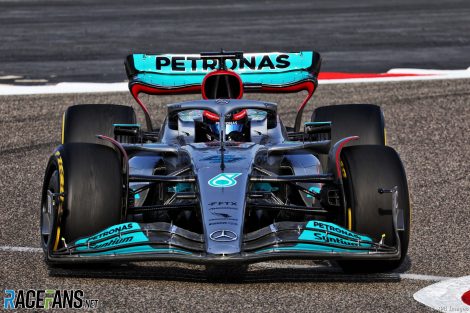
To optimise cooling, engineers have several dimensions to play around with such as the radiator surface area, fin spacing, tube diameter, expansion ratio, flow rate, and the number of coolant passes. All these different design parameters affect key characteristics of the radiators, namely drag and heat rejection. The goal of this optimisation exercise is to find the lowest drag while maintaining an acceptable amount of heat rejection in all different types of operating conditions.
One factor that is critical to the design of cooling is the heat exchanger (radiator) efficiency. This is the ratio between the actual measured amount of heat exchanged between the hot and cold mediums and the theoretical maximum. The closer this ratio is to 100%, the more efficient the heat exchanger system is, and the smaller and less dense the heat exchanger design can be.
Depending on the design of the radiator, this efficiency can also fluctuate with the temperature difference between the hot and cold fluids, the speed of the air being passed through the radiator, and the flow rate of the coolant. Novel materials, new cooling channel and fin designs, and pioneering manufacturing methods are all ways that engineers are trying to achieve maximum efficiency and maintain high efficiencies across a wide operating range.
Advert | Become a RaceFans supporter and
Innovations in cooling technology

Brand new sectors in the aerospace market such as hydrogen propulsion, supersonic passenger flight, and electric vertical take-off and landing are currently pushing the boundaries of cooling technology. In aerospace, like motorsport, it is critical to have lightweight, aerodynamic, reliable and durable design solutions. Reaction Engines is one company making headlines with its cooling technology.
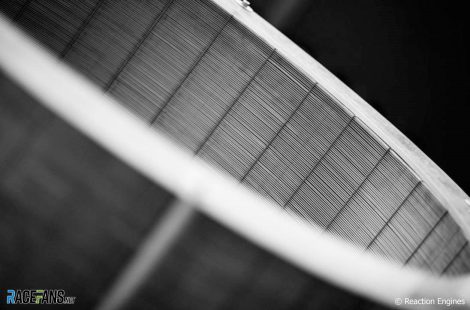
To achieve this, Reaction Engines have developed an innovative high-efficiency pre-cooler that takes the hot, ram-compressed air at temperatures that would melt the engine, and supercool it down to feed the rocket combustion chamber where it is ignited along with stored liquid hydrogen.
In 2019 the team successfully tested this pre-cooler technology and were able to quench (rapidly cool) air from 1,000C to engine inlet temperatures in 0.05 seconds. Reaction Engines have spun this innovative technology off and set up an Applied Technologies department to “apply our thermal management expertise to a range of industries” including motorsport. Such leaps in heat exchanger efficiencies would be an enormous benefit to Formula 1 teams for their cooling designs.
Other companies such as HiETA Technologies make use of advanced additive manufacturing (metal 3D printing) capabilities to design unique, lightweight and efficient heat exchangers. Additive manufacturing allows for innovative designs which could not be produced using traditional machining or casting methods. One of their innovative applications is a water charge air cooler. HiETA claims that their “charge air cooler is a single-component part that can provide a temperature decrease of up to 150°C by using two stages of cooling”. Such a lightweight and efficient solution would be very appealing to the likes of Formula 1 teams and power unit manufacturers.
Mercedes’ ‘not so new’ bold design
The new Mercedes W13 that showed up in Bahrain with little to no sidepods is a culmination of years of development. It is no secret that Mercedes has been moving all their cooling towards the middle of their car with their sidepods getting narrower and narrower and the rear half of the chassis becoming tighter over the years.
This year’s sidepods are definitely a big step in this direction, but is not something that has been achieved overnight. A design like this requires tight integration of the chassis, the power unit, aero package and, most importantly, cooling.
AlphaTauri technical director Jody Egginton suspects Mercedes have found a “very novel” new cooling technique. “It might be that their solution, combined with their PU [power unit] operating condition requirements, means that they could come up with a very novel and refined solution. So that could lead them to have a bit more freedom in terms of how they’re distributing their cooling centreline to sidepods.
“Every team is trying to package their cooling as best they can. But I’m sure it’s a conscious decision on the side of Mercedes to package in such a way to give them that freedom.”
Egginton’s team uses a Honda-developed Red Bull power unit which has a different cooling package. “We’ve got our approach to the cooling and we’re obviously with the same power unit we’ve had for a number of years now. We’re pretty confident that it’s a tight packaging solution, but it is very likely that we’re using different technologies to different PU manufacturers. This means that our distribution of cooling and the way the technologies are being used are different.”
Mercedes will of course be at pains to prevent the finer details of their system emerging. But the other significant unanswered question is what performance gains the sidepods deliver. After testing, Mercedes insisted they are not in as competitive a shape as Red Bull or Ferrari heading into the new season, claims which were greeted with scepticism by their rivals.
Become a RaceFans Supporter
RaceFans is run thanks in part to the generous support of its readers. By contributing £1 per month or £12 per year (or the same in whichever currency you use) you can help cover the costs of creating, hosting and developing RaceFans today and in the future.
Become an RaceFans Supporter today and browse the site ad-free. Sign up or find out more via the links below:
F1 technology
- Pictures: Alpine’s new front wing and more Suzuka updates
- Pictures: Red Bull bring first performance upgrade for RB20
- How teams have tweaked their cars to hit higher speeds in Jeddah
- ‘A horrible project’: Why duplicating Red Bull’s trend-setting suspension is so difficult
- Aston Martin, Mercedes, Haas and others describe extensive US GP updates




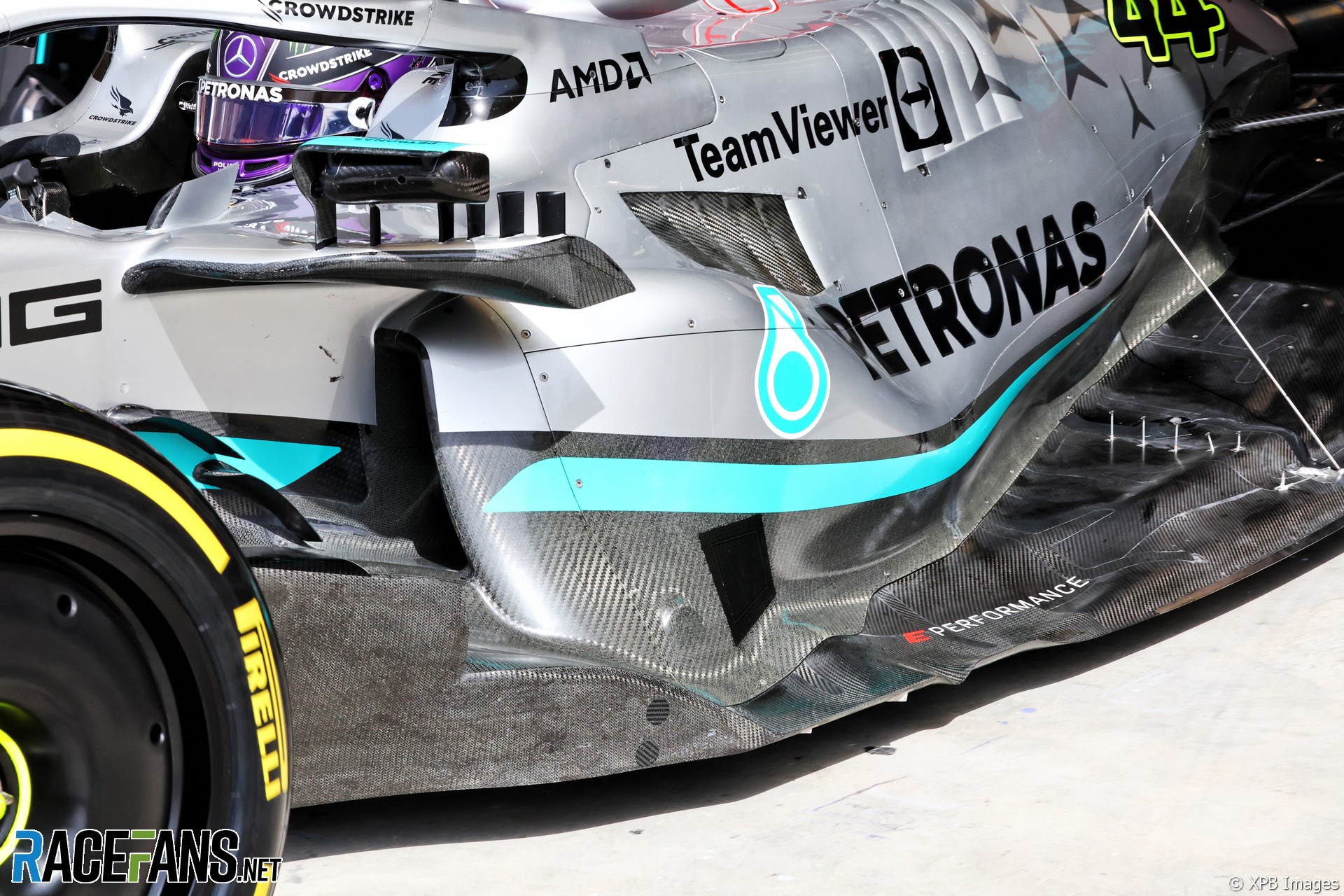
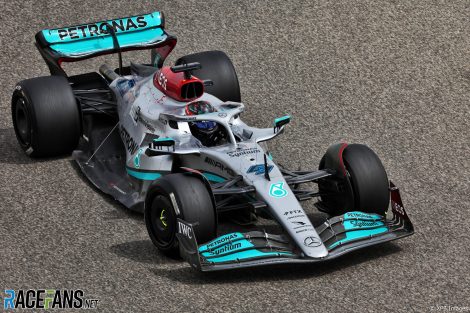
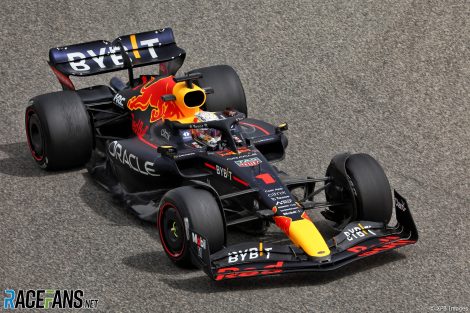
Sensord4notbeingafanboi (@peartree)
17th March 2022, 13:51
I bet merc were running these in Catalunya. I don’t know whether the RB from the outdated picture and the rb that run the last day were identical underneath, I doubt it, though both probably fundamentally the same.
Sensord4notbeingafanboi (@peartree)
17th March 2022, 14:20
And I suspect merc was already running a form of this tech last year hence the massive boost in performance.
The Dolphins
17th March 2022, 14:58
Yeah there was that “bump” in the engine cover last year which might have been an initial implementation.
AlonsoStig (@stigf1l)
17th March 2022, 13:54
In those pictures comparing RB and Mercedes cars not only the sidepods but the suspension geometry is quite different too
David BR (@david-br)
17th March 2022, 13:58
Er, is it entirely legit for F1’s chief technology officer to be blurting out who he thinks Mercedes have been working with and how their side-pod technology might be working?!
Robbie (@robbie)
17th March 2022, 14:47
@david-br Not an unreasonable question to ask, and my first thought was that perhaps Mercedes had to divulge this partner company as part of the budget cap policing, but then Symonds does say “I think” which shoots down that theory. I somehow doubt though that Symonds is breaching a confidence and I wonder if all the teams are aware of this anyway, for I just don’t see why he otherwise would speak on this. Perhaps things Mercedes are trying had to be ok’d by other teams or perhaps there was technical directives on this stuff, which made all the teams aware.
“In 2019 the team successfully tested this pre-cooler technology and were able to quench (rapidly cool) air from 1,000C to engine inlet temperatures in 0.05 seconds. Reaction Engines have spun this innovative technology off and set up an Applied Technologies department to “apply our thermal management expertise to a range of industries” including motorsport. Such leaps in heat exchanger efficiencies would be an enormous benefit to Formula 1 teams for their cooling designs.” This makes me wonder if Reaction Engines went to F1 in 2019 with what they have been working on, such that Symonds feels comfortable talking about something that perhaps is not a surprise to those within F1.
David BR (@david-br)
17th March 2022, 15:34
@robbie Well, I do presume a lot must be common knowledge, inter-team gossip, a bit of mild ‘spying’ on what other teams are up to! But you picked out precisely the key point, Symonds saying ‘I think,’ which suggests either he knows and want to be coy about it, implying that he shouldn’t be making any definite statement (e.g. ‘I know Mercedes are doing this’) or he’s speculating, in which case it isn’t ‘common knowledge’ that Mercedes are definitely doing this. Either way it suggests a breach of impartiality given that, in his position, he must have access to information from teams that they definitely don’t want sharing with others. I doubt it’s a major issue for Mercedes but it just sounds a bit like a breach of confidence given his role.
Robbie (@robbie)
17th March 2022, 15:54
@david-br Fair comment and perhaps we’ll hear more on this but I think since “it just sounds a bit like a breach of confidence given his role,” that makes me suspect it isn’t, or he wouldn’t have gone there. Can’t think of why he would do that to Mercedes and/or F1, as you say given his role.
“Mercedes will of course be at pains to prevent the finer details of their system emerging.” This tells me Symonds hasn’t said anything the other teams don’t already know, but that nobody knows exactly what Mercedes are up to, so ‘all good’ I suspect.
David BR (@david-br)
17th March 2022, 16:28
@robbie I get all that. However, just the fact he’s speculating about what they’re doing seems odd and out of tune with his F1 job. TBH it sounded to me like someone from a rival team not someone supposedly independent.
Robbie (@robbie)
17th March 2022, 16:33
@david-br Fair enough. Will be interesting to hear if this has caused a problem for Mercedes.
Coventry Climax
17th March 2022, 14:13
Nice article again, @altoono.
I’m sure the system has advantages, otherwise it wouldn’t be chosen by Mercedes. But new technologies take some time to be sorted out correctly.
In short, the question isn’t whether it is advantageous, but when will it be advantageous.
Clearly Mercedes likes us to believe they have issues at the moment, but don’t be surprised if -again- these issues are solved come raceday 1.
Mercedes have been a step ahead ever since they managed to trick the FIA into the introduction of the (their?) hybrid engine. It’s given them the air to focus on a couple of other things. DAS being a good example. Even with the new aero rules, that advantage has not changed.
sinewave (@sinewave)
17th March 2022, 14:38
Those Mercedes guys and girls must be very smart given their ability to trick the whole FIA. I would like to learn more about it. Would you, please, provide a link for starters? Thank you.
The Dolphins
17th March 2022, 15:04
@sinewave I would like to see the link as well :)
We both know that is a baseless accusation of both Mercedes and FIA by those who don’t know what’s been going on and have not been following F1 for long enough to recall the process of how the V6 hybrid design came about.
asherway (@asherway)
17th March 2022, 15:21
Baseless? Except Ecclestone, Lauda and Montezemolo all confirmed it.
Emma
17th March 2022, 18:28
Source(s)?
asherway (@asherway)
17th March 2022, 19:56
Google(s)??
anon
17th March 2022, 22:26
@asherway Lauda never made any sort of public claim that Mercedes was supposedly starting engine development in 2007.
Montezemolo apparently claimed that Lauda made that claim to him, but in the same article he also made other claims that were also demonstrably wrong – for example, claiming that Mercedes pushed for the V6 layout when, back in 2011, Montezemolo was claiming public credit for the sport switching from an inline four cylinder engine to a V6 layout. As for Ecclestone, he never claimed that Mercedes was responsible for the current engine package – he actually stated that it was Renault who was responsible for it.
We also know for a fact that Renault submitted technical papers and the results of single cylinder tests to the FIA that formed the core of the current regulation package, and that those documents were submitted to the FIA at the start of 2007.
I know that you won’t accept anything that could remotely contradict your position, because it’s clear that you have now structured your life around a narrative that you have invested so heavily in that it would likely shatter any sense of self-worth if you turned away from it now, but you really are pushing a nonsensical lie.
Izil
17th March 2022, 15:01
Renault and Ferrari were the ones pushing for hybrid engines the most.
drmouse (@drmouse)
17th March 2022, 16:07
Yeah, especially since the majority of the planning and lobbying for this design was done by other manufacturers. They must have been very clever to convince Renault and Ferrari to lobby for a design Mercedes had come up with and had some mystical head start on… Absolutely unbelievable that they could be so smart and so devious! (Literally)
grat
17th March 2022, 19:09
Incorrect. Until June 22nd, 2011, the intended rules were for a 4 cylinder turbo unit to be introduced in 2013.
Borrowed from F1 zone in 2011:
I’m unable to find James Allen’s excellent article on the development history of these rules, as his site now only exists in wayback form.
DaveW (@dmw)
17th March 2022, 14:16
This is very interesting but I’m still in the dark as to how it whether they are using some kind of innovative system for their intercooler. My first thought was they are using fuel as a coolant the way a rocket does, but running it around a plenum instead of the exhaust cone. But haven’t seen that explained.
SteveR
17th March 2022, 14:18
I have one small nit to pick with this excellent analysis:
should read ‘does’. The great the temperature delta the greater the heat transfer.
Macademianut (@macademianut)
17th March 2022, 14:32
This site below talks about the changes in their gearbox. Perhaps the cooling helped them get a bit more power.
http://www.formulapassion.it/opinioni/federico-albano/formula1-f1-mercedes-il-cambio-e-ancor-piu-estremo-dellaerodinamica-ferrari-alpine-dati-rapporti-608685.html
Nulla Pax (@nullapax)
17th March 2022, 14:49
Ah-Haa – Have they managed to focus all the hot air that comes out of Lewis during a race?
Sorry – sorry ….. :(
Well that has probably made me a few more enemies so I will go hide now for a while ;P
John Cousins (@drone)
17th March 2022, 15:10
I’m wondering if they are using a form of capillary radiator? A complex metal foam inside a structure transmits the heat from a liquid into the outer skin of the structure. (its casing)
Effectively a radiator with no fins..just an outer skin in which the heat is radiated from… Obviously there are huge aerodynamic advantages there and most likely used for water to air intercooling of the pressurised inlet charge from the turbo. This is just a guess of course, I don’t actually know how effective they would be on an F1 car…
grat
17th March 2022, 19:13
You aren’t the first to suggest it.
Wheel Nut (@wheel-nut)
17th March 2022, 15:24
The Merc seems to be generating a lot of downforce but is not that controlled at times. If they can get it under control then it could be very fast. With the effort required to both repackage the engine and develop equivalent cooling technology then it would seem that it will take a lot of time and money to replicate if it proves to be the winning formula
grat
17th March 2022, 19:29
Exactly. Their very small sidepod allows for massive airflow along the side of the car, which supercharges the rear diffuser by creating a very fast moving, high volume of air on top of the car, and a large, slow moving mass under the car.
It quite literally sucks to be them. *ahem*.
Ed
17th March 2022, 15:41
What i expect to happen with this is that while the solution is novel and to be applauded for ingenuity and technical innovation i’d image that the next set of rules will dictate that from the centre line of the car the structures that are classified as side pods must extend to a minimum of xxxmm from that line. This will still allow us to see the different shapes we have at the moment from RB, Ferrari, Aston and Williams at present
drmouse (@drmouse)
17th March 2022, 16:11
I have to wonder why. As long as this doesn’t negatively affect the amount of or reaction to dirty air, there’s no real reason to do so.
They may decide to ban certain more advanced cooling methods as a cost control measure, which may render this packaging impractical in the future, but other than that I see no benefit to forcing a certain minimum size of sidepod.
grat
17th March 2022, 19:34
Why?
Ciaran (@ciaran)
17th March 2022, 16:11
Another great article Alto.
Fascinating to see the technology overlap between these different environments. I wonder if something like Reaction Engine’s Applied Technologies division is what some F1 teams are gunning for in the future, where they can sell off the innovations they’ve come up with?
DrG (@drgraham)
17th March 2022, 16:17
I simply cannot believe that Pat Symonds has been so completely unprofessional in his current position to even discuss a competitors designs or partners.
Then on the other hand Singapore 2008…
JohnS
17th March 2022, 17:38
Some of us in the industry still don’t believe Reaction Engines claims.
I will leave it at that. Good Luck to Mercedes.
Emma
17th March 2022, 18:31
Just in case Mercedes are indeed using Reaction Engines tech, do you think they wouldn’t have sufficiently tested and verified it before putting it in production?
RICH#4131
18th March 2022, 5:52
Agreed
RandomMallard
17th March 2022, 18:47
Another excellent article Alto. I think the Mercedes this year has great potential (and you can’t fault their ingenuity), but in testing they seemed to be struggling to fully utilise it. Although I am wary because it’s Mercedes and testing. I wouldn’t be surprised to see them on pole, but at the same time they could be languishing in the upper midfield. Only time will tell. Bring on this weekend!
Johns
17th March 2022, 20:06
The trouble is they have no way to energize the air to the diffusse with their concept. They are just relying on a good free stream flow. Might work in tunnel but a stiff cross wind?
floodo1
17th March 2022, 19:26
thanks for the in-depth explanation of the context/background
ferrox glideh (@ferrox-glideh)
18th March 2022, 2:00
This is the kind of thing that keeps me following F1 season after season. Really interesting article!
iCarbs (@icarby)
18th March 2022, 7:47
Fascinating, these articles are more interesting than reading about FIA corruption.
Tornado (@tornado)
18th March 2022, 8:56
I wonder if the novel cooling solution is part of the engine package, or is a separate thing, like the radiator. I mean do the customer teams get the benefit of this tech, and therefore can shrink their bodywork, probably for next year’s car, if they need to, or not?
Robert
18th March 2022, 14:47
I think the cooling package can be part of a power unit supply deal, but doesn’t have to be. Some speculate that Williams are running the full Mercedes package, but McLaren have their own cooling solution. That would make sense to me judging by the look of their cars. Williams is extremely tightly packaged with the bulk of its volume along the centerline, like the Mercedes, while the McLaren seem to have more volume in their sidepods but perhaps a slightly slimmer engine cover.
Hermani
19th March 2022, 7:36
A couple of years ago – possibly the technology transfer conduit
“In this new role Steve (Gill) will be responsible for building and growing the Company’s Applied Technologies Business Division …
Most recently Steve held the position of General Manager for Red Bull Advanced Technologies, disseminating and commercialising F1 technology.”
If it does prove a difference + 1 for Toto (otherwise +3 for HM/CH for the long game).